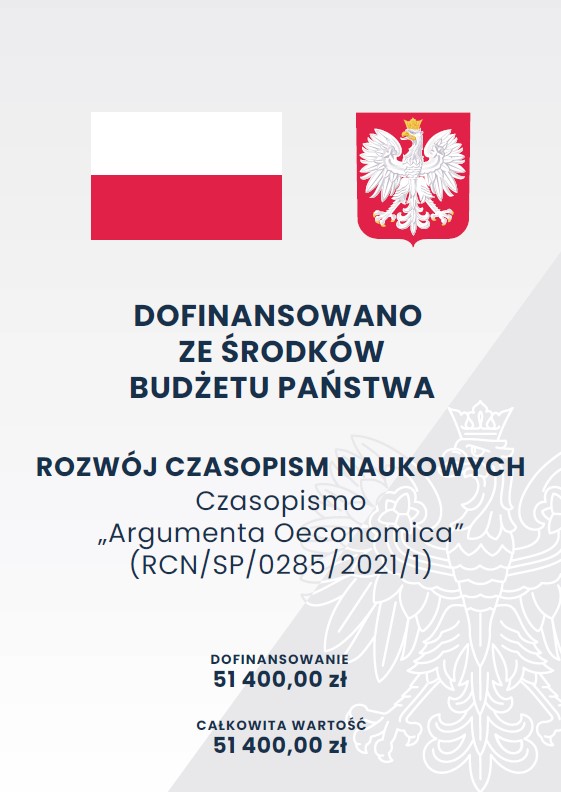Social capital as an interdisciplinary concept
DOI:
https://doi.org/10.15611/aoe.2025.2.04Keywords:
social capital, interdyscyplinarity, trust, scientometric analysis, keyword mapAbstract
Aim: The main purpose of the article was to present the interdisciplinary nature of the concept of social capital on the basis of own research.
Methodology: The research method used was a scientometric analysis conducted based on items found in the Web of Science database. For the literature search visualisation was performed using the VOSviewer application, and the methodology used allowed for a comprehensive assessment of the co-occurrence of keywords in scientific publications on social capital, as well as an overview of the scientific categories to which these publications were assigned.
Results: The analyses led to conclude that the concept of social capital is correlated with a wide range of terms anchored in various research disciplines. The perceived multiplicity of approaches to the category of social capital in the literature also results in the wealth of scientific definitions formulated and the possibilities of operationalisation, which further strengthens the interdisciplinary evaluation of this category. This is evident in attempts to embed it on various cognitive levels and to assign multiple causal powers based on the considerations carried out.
Implications and recommendations: This article attempts to fill the cognitive gap in the analysis of the interdisciplinary nature of the concept of social capital. It is an expression of the position taken by the author that the conceptualisation and operationalisation of this category visible in the literature, does not have to be accidental and occasional. The adopted research methodology, i.e. a scientometric analysis, allowed for the elimination of incidental (singular) connections between words of terms cooccurring in the base.
Originality/value: The observed multiplicity of definitions of this concept, according to some researchers, indicates its scientific immaturity. However, there is still a belief in the many positive effects that the building of social capital and its proper use in various social groups causes. In the author’s opinion the conducted research is scientifically justified as it provides a clear statement about the interdisciplinary nature of the category of social capital.
Downloads
References
Adler, P. S., & Kwon, S. W. (2002). Social capital: Prospects for a new concept. The Academy of Management Review, 27(1), 17-40.
Baker, W. E. (1990). Market networks and corporate behavior. American Journal of Sociology, 96, 589-625.
Baraniecka, A. (2014). Raportowanie o poziomie kapitału społecznego w Polsce. Stan obecny i perspektywy. Prace Naukowe Uniwersytetu Ekonomicznego we Wrocławiu, 338, 20-39.
Berger, G. (1972). The interdisciplinary archipelago. In L. Apostel, E. Jantsch, & J. Piaget (Eds.), Interdisciplinarity. Problems of Teaching and Research in Universities (pp. 35-74). OECD.
Bourdieu, P. (1985). The forms of capital. In J. Richardson (Ed.), Handbook of Theory and Research for the Sociology of Education (pp. 241-258). Greenwood Press.
Boxman, E. A. W., De Grant, P. M. & Flap, H. D. (1991). The impact of social human capital on the income attainment of Dutch managers. Social Networks, 13, 51-73.
Bratnicki, M. (2000). Podstawy współczesnego myślenia o zarządzaniu. Wydawnictwo Naukowe TRIADA.
Coleman, J. S. (1988). Social capital in the creation of human capital. American Journal of Sociology, 94, 95-120.
Craig, A. W., & Storr, V. H. (2022). Is social capital underproduced? Journal of Public Finance and Public Choice, 37(1), 123-147.
Czapiński, J. (2015a). Jakość życia w Polsce – wygrani I przegrani. In J. Czapiński, & T. Panek (Eds.), Diagnoza Społeczna 2015. Warunki i jakość życia Polaków. Raport (pp.415-442).
Czapiński, J. (2015b). Stan społeczeństwa obywatelskiego. In J. Czapiński, & T. Panek (Eds.), Diagnoza Społeczna 2015. Warunki i jakość życia Polaków. Raport (pp.332-372).
DiIulio, J. J. (1996). Help wanted: Economists, crime and public policy. Journal of Economic Perspectives, 10(1), 3-24.
Flap, H. D. (2002). No man is an island: The research programme of social capital theory. In E. Lazega, & O. Favereau (Eds.), Conventions and Structures. Oxford University Press.
Frykowski, M., & Starosta, P. (2008). Kapitał społeczny i jego użytkownicy. Przegląd socjologiczny, 57(1), 31-62.
Fukuyama, F. (1995). Trust: The Social Virtues and the Creation of Prosperity. Free Press.
Fukuyama, F. (2003). Kapitał społeczny. In L. E. Harrison, & S. P. Huntington (Eds.), Kultura ma znaczenie. Wydawnictwo Zysk i S-ka.
Fukuyama, F. (2009). Koniec historii. Wydawnictwo Znak.
Gajowiak, M. (2012). Kapitał społeczny. Przypadek Polski. Polskie Wydawnictwo Ekonomiczne.
Genge, E. (2015). Zaufanie do instytucji publicznych i finansowych w polskim społeczeństwie – analiza empiryczna z wykorzystaniem ukrytych modeli Markowa. Prace Naukowe Uniwersytetu Ekonomicznego we Wrocławiu. Research
Papers of Wrocław University of Economics, 384, 100-107.
Granovetter, M. (1973). The strength of weak ties. American Journal of Sociology, 78(6), 1360-80.
Grudzewski, W. M., Hejduk, I. K., Sankowska, A., & Wańtuchowicz, M. (2009). Zarządzanie zaufaniem w przedsiębiorstwie – koncepcje, narzędzia, zastosowania. Oficyna Wydawnicza Wolters Kluwer.
Hanifan, L. J. (1916). The rural school community center. Annals of the American Academy of Political and Social Science, 67(1), 130-138.
Jędrych, E., & Berniak-Woźny, J. (2018). Kształtowanie kapitału społecznego organizacji. Wydawnictwo Naukowe PWN.
Kawachi, I., Kennedy, B. P., Lochner, K., & Prothrow-Stith, D. (1997). Social capital, income inequality, and mortality. American Journal of Public Health, 87(9), 1491-1498.
Knack, S. (2002). Social capital, growth, and poverty: A survey of cross-country evidence. In C. Grootaert, & T. van Bastelaer (Eds). The Role of Social Capital in Development: An Empirical Assessment (pp. 42-82).Cambridge University Press.
Knack, S., & Keefer, P. (1997). Does social capital have an economic payoff? A Cross-country investigation. The Quarterly Journal of Economics, 112(4), 1251-1288.
Kwon, S.W., & Arenius, P. (2010). Nations of entrepreneurs: A social capital perspective. Journal of Business Venturing, 25(3), 315-330.
Libertowska, A. (2020). Kapitał społeczny w zarządzaniu wartością przedsiębiorstw. Polskie Towarzystwo Ekonomiczne.
Lin, N. (1999). Building a network theory of social capital. Connections, 22(1), 28-51.
Liu, C., Cao, J., Duan, K., & Wu, G. (2023). Effect of network position on inter-team conflict and project success in megaprojects. Engineering, Construction and Architectural Management, 30(10), 4955-4977.
Markowska-Przybyła, U. (2014). Kapitał społeczny a wzrost i rozwój gospodarczy – wybrane aspekty teoretyczne. Prace Naukowe Uniwersytetu Ekonomicznego we Wrocławiu, 333, 109-120.
Markowska-Przybyła, U. (2023). External social capital of enterprises in Poland. Polish Journal of Management Studies, 27(1), 202-220.
Martikke, S. (2017, October). Social capital – an overview. GMCVO – Research. Retrieved June 3, 2024 from https://www.gmcvo.org.uk/system/files/publications/Social%20Capital%20-%20An%20Overview.pdf
McElroy, M. W. (2002). Social innovation capital. Journal of Intellectual Capital, 3(1), 30-39.
Mountford, N., I. Chouvarda, M. Isomursu, & B. Caulfield (2017). Vectors and drivers of connected health in Europe: A foundation for integrated care. International Journal of Integrated Care, 17(5), 1-8.
Norbutas, L., & Corten, R. (2018). Network structure and economic prosperity in municipalities: A large-scale test of social capital theory using social media data. Social Networks, 52, 120-134.
Piazza, M., Mazzola, E., Abbate, L., & Perrone, G. (2019). Network position and innovation capability in the regional innovation network. European Planning Studies, 27(9), 1857-1878.
Portes, A. (1998). Social capital. Its origins and applications in modern sociology. Annual Review of Sociology, 24, 1-24.
Putnam, R. D. (1993). What makes democracy work? National Civic Review, 82(2), 101-7.
Putnam, R. D., Leonardi, R., & Nanetti, R. Y. (1993). Making Democracy Work: Civic Traditions in Modern Italy. Princeton University Press.
Racki, G. (1999). Naukometria, bibliometria, publikacje, cytowania. Gazeta Uniwersytetu Śląskiego, 8(64). https://gazeta.us.edu.pl/node/192691
Sankowska, A. (2011). Wpływ zaufania na zarządzanie przedsiębiorstwem – perspektywa wewnątrzorganizacyjna. Difin.
Son, J., & Lin, N. (2008). Social capital and civic action: a network-based approach. Social Science Research, 37(1), 330-349.
Stephan, U., & Uhlaner, L. M. (2010). Performance-based vs. socially supportive culture: a cross-national study of descriptive norms and entrepreneurship. Journal of International Business Studies, 41(8), 1347-1364.
Sztompka, P. (2016). Kapitał społeczny. Teoria przestrzeni międzyludzkiej. Wydawnictwo Znak.
Theiss, M. (2012). Krewni – znajomi – obywatele. Kapitał społeczny a lokalna polityka społeczna. Publishing House Adam Marszałek.
The World Bank (1998). Social capital: the missing link? Social Capital Initiative. Working Paper. No. 3.
Torsvik, G. (2000). Social capital and economic development: A plea for the mechanisms. Rationality and Society, 12(4), 451-476.
Turner, J. H. (1999). The formation of social capital. In P. Dasgupta & I. Serageldin (Eds.), Social capital: A multifaced perspective (pp. 94–146).The World Bank Publications.
Wallace, C., Shmulyar, O. & Bedzir, V. (1999). Investing in social capital: The case of small-scale, cross-border traders in post-communist Central Europe. International Journal of Urban and Rural Research, 23(4), 751-770.
Węgrzyn, G. (2016). Zasoby ludzkie dla nauki i techniki jako potencjał innowacyjny gospodarek – analiza porównawcza. Studia i Prace Wydziału Nauk Ekonomicznych i Zarządzania, 44(2), 385-397.
Woolcock, M. (1998). Social capital and economic development: Toward a theoretical synthesis and policy framework. Theory and Society, 27, 151-208.
Downloads
Published
License
Copyright (c) 2025 Andżelika Libertowska

This work is licensed under a Creative Commons Attribution-ShareAlike 4.0 International License.
Accepted 2024-12-18
Published 2025-08-01








